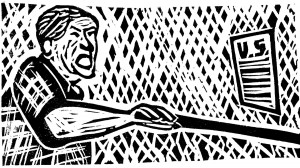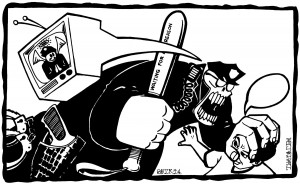The Cops ARE in My Head – Redux
Some weeks ago, I wrote a post inspired by my friend Paula Rojas’s contention that the “cops are in our heads and hearts.”
I write a lot about the police on this blog. This is because cops play such a major role as gatekeepers for the prison industrial complex. It is also because so many of the young people (particularly young men of color) who I work with are consumed by the role that cops play in their lives. This has prompted me to spend the past few months working on a new curriculum about the history and current manifestations of police violence in the U.S. I hope to release it some time this fall.
Yesterday my organization offered the second session of an ongoing juvenile justice advocacy training program that we are co-sponsoring with the Hull House Museum. It was a terrific session that featured presenters who helped participants to better understand the role of key players within the juvenile justice system. So we had a lawyer who works to advocate with youth when they are initially arrested speak about young people’s rights with the police. We heard from the chief prosecutor for Cook County’s juvenile justice bureau. We heard from a terrific juvenile court judge and finally we heard from a senior administrator in the probation department. Over 30 people were in attendance on a snowy Saturday in Chicago. This is a testament to how resonant these issues are for community members.
Back to my discussion about the cops being in my head… It turns out that the cops are in ALL OF OUR HEADS. During yesterday’s street law presentation, I was surprised by how many workshop participants could not get past the fact that citizens have very limited rights in our interactions with the police. It points to how much we all take state power for granted in our society. The power of the state to regulate our lives is mighty. No matter how many times and in how many ways it was reiterated that the best posture to adopt with the police was to SAY NOTHING and to ASK FOR A LAWYER, people were fixated with wanting to know if they had the right to know why they were being arrested. People wanted to know if they could refuse to give their consent to be searched. People wanted to basically know if they could resist the intrusion of police power in their lives. Unfortunately the sad reality is that our rights vis-a-vis the police are incredibly limited. This is very frustrating even and perhaps anger-producing but it is the truth.
I tell the young people who I work with that when they are stopped by the police, they need to stop, make no movements that can be interpreted as fleeing or going for a weapon, and SAY NOTHING. I tell them to give their identifying information, name, birthday, address. I tell them to ask for a phone call and to say that they want a lawyer. THAT IS IT. Individuals cannot resist the police by themselves on the street. That is a losing proposition. Put your hands on a police officer FOR ANY REASON and be prepared for a felony charge of resisting arrest or attempted aggravated battery. I have known a few people who have been so accused. Social movements must hold cops and the state accountable. If we have mass mobilization and we each do our part, then we win. We cannot fight the state as individuals.
History provides some hopeful examples of community mobilization to address police violence. In her book Street Justice: A History of Police Violence in New York City, Marilynn S. Johnson suggests that urban residents began complaining and organizing against police brutality in the mid-19th century. In fact, the first major investigation into police misconduct was launched in New York City in 1894 through the Lexow Committee. This Committee found police abuses including corruption, brutality and perjury. In the late 19th century, the most common complaint from urban residents against the police was about “clubbing” which was “the routine bludgeoning of citizens by patrolmen armed with nightsticks or blackjacks.”
Johnson analyzed 270 articles in the New York Times from 1865 to 1894 that report on cases of alleged police brutality. She found that three-quarters of all cases covered by the Times involved clubbing, “the majority occurring between a uniformed officer and a single unarmed suspect.” She notes that “[i]njuries and deaths resulting from such beatings were common, with 9 percent of victims dying during or soon after the encounter.” Most of the reported cases of violence occurred in poor immigrant neighborhoods and involved young men. She adds that “[p]olice attacks on women, however, were not uncommon. Women suspects were involved in 20 percent of all cases.”
Johnson offers the story of John McDonald as an example of police violence in the late 19th century.
“Around midnight one summer evening in 1881, John McDonald and his wife sat down on the stoop of their home on Second Avenue. They had spent the last several hours caring for a sick child and decided to step outside to cool off. Before long, Officer Montgomery Ditmars of the Nineteenth Precinct strolled by and stopped in front of their house. With what the New York Times called “a pompous show of authority,” he ordered the couple back inside. Tired and hot, John McDonald refused and told the officer to mind his own business. After further argument, Officer Ditmars drew his club and pummeled McDonald about the head and face until he begged for mercy. He then arrested both husband and wife for disorderly conduct and hauled them down to the station house, where the couple spent the night in a cell.”
You can read the book to find out what happened to the McDonalds and to Officer Ditmars 🙂 My point in highlighting this story and pointing to the history of police violence is to suggest that it has been with us for a long time and that people have been mobilizing against it for just as long. Improvements have been made over time and yet the intractability of police violence is a challenge to us all. As I continue to learn more about this history, I hope to share more information. In the meantime, I guess that the cops are going to keep being in my head…


